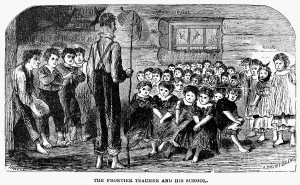Throughout our deliberation unit, the term ‘tracking’ came up frequently and it occurred to me that the definition remained rather vague. So for this week’s civic issue blog, I decided to take a look at what tracking really is.
When someone brings up the idea of tracking, people often immediately jump to think about foreign school systems. Countries such as Germany and Singapore begin separating students around sixth grade (or earlier, depending on the region). This kind of tracking is on a large scale where students take a test that places them into a high, middle, or low track. This placement determines the level of difficulty as well as the expectations for post-graduation work. This is the most common view of tracking. (**Although the focus of this blog post is not on whether these other nations’ wholesale tracking system is better or worse than our own, there is much debate over the effect it has on achievement. Click here to read about several Asian countries’ systems.)
However, tracking encompasses much more than sorting students into different schools. School districts where children progress through grade levels without taking a placement test often still track their students. To start, I would like to pose a question: how many of you took AP classes in high school? How many of you took almost exclusively AP classes? Were your electives separated by level of difficulty or did everyone mesh together regardless of ability? In elementary school, did your teacher separate you into different reading groups depending on ability? All of these are forms of tracking.
To shed some light on how the United States arrived at these various forms of tracking, let’s take a look at our educational history. Before the nineteenth century, schools were usually one-room schoolhouses where students learned from the books they had at home that they brought in or had no books and learned basic skills like reading and writing in a lecture-style class overflowing with students of all different ages. By the mid-nineteenth century, however, the school system was transforming into a more hierarchical organization with certain subjects designated for certain grade levels and a narrower range of ages for students. Still, students progressed through levels of schooling based upon their mastery of the material rather than how old they were.
By the turn of the century, high school-aged students were pouring in and the schools leaned more towards separating grade levels by age and promising a single, uniform diploma for all graduates. America’s focus switched from what grade level one could attain to what level one attained within that grade level (accelerated, standard, low level classes). By the 1960’s, schools became more standardized nationally on what subjects should be taught in what order. Programs like gifted and special education came into existence as a distinct form of tracking for students with abnormal abilities. The mid-twentieth century witnessed the shift towards mass intelligence testing and schools started to adopt IQ testing as the method of separating students. **Read more about the evolution of tracking and what social and political events helped shape our system here.
So that brings us to today. (Here I will focus on schools that do not employ wholesale tracking because the norm in the United States is not to sort students into different schools based on a single test, although this does still happen.) Whereas the tracks into which schools funneled students for much of the twentieth century were rigid and limiting, today’s tracking system offers much more flexibility. IQ testing as a means to sort students no longer exists (except for placement into special and gifted education, and even then IQ is not necessarily the deciding factor). Tracking is typically done within each subject and it is academic performance and teacher recommendations that determine which track students should enter. And these decisions are almost always negotiable.
Perhaps the most important development in tracking has been the preparation these classes offer for the future. For most of American educational history, the lower tracks severely limited career paths. Although differences in the curricula still exist, all levels of classes have a focus on preparation for college. I believe this coincides with the notion that higher education is now a reality (even an expectation) for every student, not just the cream of the crop. This is an important development because it allows for every student to earn a university degree if they work hard enough, which seems essential in today’s work market.
The current controversy on tracking rests mainly on whether tracking is inequitable and unfair. Does tracking still limit learning? Should there be more guidance and rigor at every level?


Tracking seems like it would be a good idea if it were done more flexibly. If students were put into specific tracks, but then upon excelling were allowed to move up and forward into higher level tracks, this system might benefit students more than traditional schooling where you just lump the students together. I would like to see some statistics about the benefits of tracking, or how people feel about it overall. This would enhance your post.
I think the tracking system, if done correctly, can benefit all students. For strong students, tracking allows them to be around others who are around their academic level. Classes can move faster and students can get more out of their courses and time in school. When looking at tracking, people often think that the weaker students get the short end of the stick, but I do not think that this has to be the case. Weaker students cannot handle AP or honors courses and would be in way over their heads in those classes. A completely mixed skill level class might move too fast for some students and tracking allows them to be in classes that are at their levels. They too will get more out of these classes. In my opinion the most important thing about tracking is whether it is across the board or by class. I think that tracking that is in the A, B, C etc. system for evert class is limiting – students might be better in one subject than another, but not allowed to take any higher level courses based on their lower track. Tracking that is class specific is the better route to take. This is what my high school did, and I think that it benefited students of all levels.
I definitely support the idea of tracking through classes as opposed to a singular test. I was dubbed “gifted” in the first grade and was a member of my school’s gifted program throughout my educational career. Now, I’m not trying to sound like a snob here. I in no way felt better than other kids as a result of being tracked into the AP and honors courses. But without them, at a level standard for my age group, I was bored. I talked too much and didn’t pay attention to the teacher because everything seemed to easy. My grades suffered a lot until my school provided me with more challenging subjects. On the whole I think that the current system of tracking functions well, though I believe that measures should be taken to ensure that tracking only enhances the student’s experience; it should never limit potential or cut off opportunities.
I’ve looked at some of the previous comments and what you’ve said about tracking, and I must say I have mixed feelings. While there are some students that get left behind and suffer, there are some students that are able to really succeed. And personally, as a product of a public school system where stabbings are now a regular occurrence, I think it has helped me succeed. But I do like your comparison with what was happening in the past versus what is happening now, it allows for a broader scope on the root of the issue.
I also appreciate that you focused on the development of US education so that readers can better understand how we got to where we are today. This was a strong historical post, but I would also like to see a complementary post in which you analyze the situation of tracking based on studies or personal experience.
I have very mixed feelings about tracking. While it seems to be a limitation to lower ranking students and comes with all kinds of problems, I also think it’s a generally good idea. I come from a crappy, and I mean crappy, public school. We have the 3rd highest crime rate in the state and drug use runs rampant IN the school. It is not uncommon to walk to the bathroom and find a girl smoking a joint in the stall next to you. If you’re really lucky, she’ll be having sex with another student as well. Teen pregnancy is so prevalent that there is a specific track in HS (and Middle School. MIDDLE SCHOOL!) if you happen to get knocked up anywhere from grades 6 to 12. I am obviously not a dope smoking teen mom, so the tracking system for me was a blessing in disguise.
The points I appreciate about this article are how you progressed through time, thus giving a background of yesterday vs today. This give the reader a better understanding of what is going on and also you pose questions in order to draw the reader in and stimulate thought into their minds, which I believe is very important in this type of post. In order to improve this post it would be good to include statistics on what americans think of tracking, as they will be your captured audience, as well as statistics on the results of both extremes of tracking and complete integration.